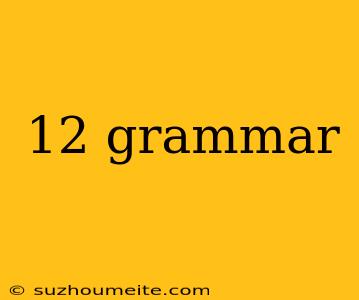12 Tenses Grammar: A Comprehensive Guide
Mastering the 12 tenses in English grammar is essential for effective communication and expression. In this article, we will explore the 12 tenses, their forms, and examples to help you improve your English language skills.
1. Present Simple
The present simple tense is used to describe habits, routines, and general truths.
- Form: Base form of the verb (e.g., walk, run, eat)
- Example: I eat breakfast at 8 am.
2. Present Continuous
The present continuous tense is used to describe actions that are happening now.
- Form: Present tense of the verb "to be" (am, is, are) + present participle of the main verb (e.g., eating, running, writing)
- Example: I am eating breakfast now.
3. Present Perfect
The present perfect tense is used to describe actions that started in the past and continue up to the present.
- Form: Present tense of the verb "to have" (has, have) + past participle of the main verb (e.g., eaten, written, learned)
- Example: I have eaten breakfast already.
4. Present Perfect Continuous
The present perfect continuous tense is used to describe actions that started in the past and continue up to the present.
- Form: Present tense of the verb "to have" (has, have) + been + present participle of the main verb (e.g., eating, running, writing)
- Example: I have been eating breakfast for an hour.
5. Past Simple
The past simple tense is used to describe completed actions in the past.
- Form: Past tense of the verb (e.g., walked, ran, ate)
- Example: I walked to school yesterday.
6. Past Continuous
The past continuous tense is used to describe actions that were in progress at a specific point in the past.
- Form: Past tense of the verb "to be" (was, were) + present participle of the main verb (e.g., eating, running, writing)
- Example: I was eating breakfast when the phone rang.
7. Past Perfect
The past perfect tense is used to describe actions that happened before another action in the past.
- Form: Past tense of the verb "to have" (had) + past participle of the main verb (e.g., eaten, written, learned)
- Example: I had eaten breakfast before I went to school.
8. Past Perfect Continuous
The past perfect continuous tense is used to describe actions that started before another action in the past and continued up to that time.
- Form: Past tense of the verb "to have" (had) + been + present participle of the main verb (e.g., eating, running, writing)
- Example: I had been eating breakfast for an hour when my friend arrived.
9. Future Simple
The future simple tense is used to describe actions that will happen in the future.
- Form: Will + base form of the verb (e.g., walk, run, eat)
- Example: I will eat breakfast at 8 am tomorrow.
10. Future Continuous
The future continuous tense is used to describe actions that will be in progress at a specific point in the future.
- Form: Will + be + present participle of the main verb (e.g., eating, running, writing)
- Example: I will be eating breakfast when you arrive.
11. Future Perfect
The future perfect tense is used to describe actions that will be completed at a specific point in the future.
- Form: Will + have + past participle of the main verb (e.g., eaten, written, learned)
- Example: I will have eaten breakfast by the time you arrive.
12. Future Perfect Continuous
The future perfect continuous tense is used to describe actions that will continue up to a specific point in the future.
- Form: Will + have + been + present participle of the main verb (e.g., eating, running, writing)
- Example: I will have been eating breakfast for an hour when you arrive.
Mastering the 12 tenses in English grammar can take time and practice, but with this guide, you'll be well on your way to improving your language skills.
